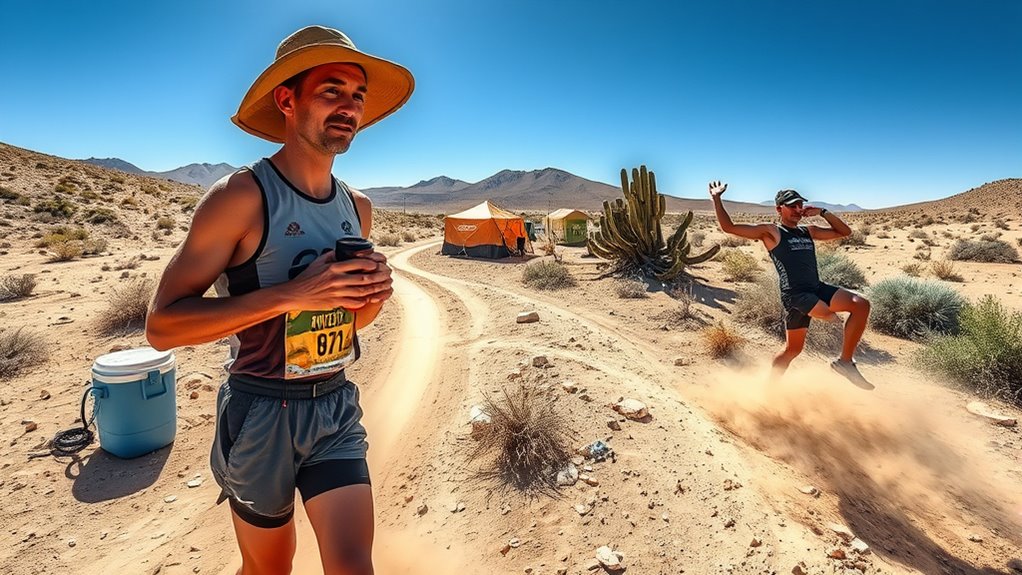To manage fatigue during 100-mile desert sprints, pace yourself carefully from the start and break the race into manageable segments. Stay proactive with hydration and electrolytes, drinking small amounts regularly, andeat quick, digestible snacks to keep energy stable. Watch for early signs of physical and mental tiredness and respond promptly with rest, hydration, or pace adjustments. Using these strategies, along with environmental awareness, will help you conserve energy and stay resilient throughout the race. Keep going to uncover more expert tips.
Key Takeaways
- Pace yourself gradually from the start, breaking the race into manageable segments with small goals.
- Regularly hydrate and replenish electrolytes to prevent dehydration and maintain energy levels.
- Recognize early signs of physical and mental fatigue to respond promptly with rest or effort adjustments.
- Use strategic short breaks for rehydration, refueling, and mental reset to prevent burnout.
- Adapt your pace and gear to environmental conditions like heat and dust to reduce overall fatigue.
Planning Your Race Strategy for Energy Conservation

To conserve energy during a 100-mile desert race, you need a solid race strategy from the start. Begin by pacing yourself carefully, avoiding the temptation to push too hard early on. Break the race into manageable segments, setting small goals to stay motivated without overexerting. Plan your effort levels based on terrain; conserve energy on hills and rough patches, and accelerate on easier sections. Wear lightweight, breathable clothing to prevent overheating. Use your energy wisely by focusing on steady, consistent movement instead of sudden bursts of speed. Remember, maintaining a sustainable pace is key to lasting the full distance. Incorporating mindful decluttering techniques can help you stay focused and reduce mental clutter during long races. A well-thought-out strategy helps prevent burnout and keeps your energy reserves intact for the most challenging parts of the race.
Prioritizing Hydration and Electrolyte Balance

Maintaining proper hydration and electrolyte balance is key to sustaining your energy and preventing cramps during a 100-mile desert race. As you race through extreme heat and dehydration risk, drink fluids regularly, even before you feel thirsty. Use electrolyte-rich drinks to replenish sodium, potassium, magnesium, and calcium lost through sweat. Monitor your urine color; light-colored urine indicates good hydration. Don’t overhydrate, as it can cause hyponatremia, a dangerous imbalance. Incorporate small, frequent sips rather than large amounts at once. Plan your intake based on the weather, your sweat rate, and race pace. Staying ahead of dehydration helps maintain muscle function, mental focus, and overall endurance. Prioritizing electrolytes alongside water to keep your body’s internal balance steady throughout the grueling 100 miles. Color accuracy in your hydration strategy ensures optimal visual cues for hydration levels and overall health.
Managing Nutrition for Sustained Energy

To keep your energy steady, you need to focus on proper fuel timing, making sure you’re eating at regular intervals. Hydration and electrolytes play a key role in maintaining your stamina and preventing cramping. Balancing carbohydrate intake helps sustain your effort without causing crashes or digestive issues.
Fuel Timing Strategies
Effective fuel timing is essential for sustaining energy during a 100-mile desert sprint. You need to plan when to consume calories to maintain your blood sugar levels without causing stomach discomfort. Start with a balanced breakfast before the race and take small, easily digestible snacks every 30 to 45 minutes. Avoid large meals that can slow digestion or cause cramping. During the race, prioritize quick-absorbing carbs like gels or chews to boost energy quickly. As fatigue sets in, adjust your intake to prevent energy dips. Don’t wait until you’re hungry or tired to refuel; proactive timing keeps your energy stable. Properly timed fueling helps you stay focused, reduces fatigue, and improves endurance throughout the grueling miles.
Hydration and Electrolytes
Staying properly hydrated and maintaining balanced electrolyte levels are essential for preventing fatigue and muscle cramps during a 100-mile desert sprint. You need to drink regularly, but not excessively, to replace fluids lost through sweat. Electrolytes like sodium, potassium, magnesium, and calcium help your muscles function smoothly and prevent cramping. Consider using electrolyte supplements or sports drinks that contain these minerals, especially in hot conditions. Paying attention to your body’s signals—thirst, dark urine, or muscle twitches—indicates dehydration or imbalance. Incorporate small, frequent sips rather than large volumes at once. Proper hydration and electrolyte management optimize your performance, reduce fatigue, and keep your muscles functioning efficiently throughout the grueling race. Additionally, understanding how eye patch benefits can aid in reducing eye strain and fatigue may help you stay alert during long hours of exertion.
Balanced Carbohydrate Intake
Maintaining a balanced carbohydrate intake is essential for fueling your body and sustaining energy levels throughout a 100-mile desert sprint. Carbohydrates provide quick, accessible energy needed for endurance. Aim to consume a mix of simple carbs for immediate energy and complex carbs for sustained release. Timing is key—consume carbs regularly to prevent dips in blood sugar. Here’s a quick guide:
| Carbohydrate Type | Examples | Benefits |
|---|---|---|
| Simple carbs | Gels, fruit, sports drinks | Fast energy release |
| Complex carbs | Oats, whole grains, pasta | Long-lasting energy |
| Combination | Energy bars, smoothies | Balanced energy supply |
Stay consistent with your intake, and adjust based on your energy needs and conditions. Proper carb management keeps fatigue at bay.
Recognizing and Responding to Early Signs of Fatigue

Pay close attention to physical cues like muscle soreness or aching joints, as they can signal fatigue before it worsens. Mental and emotional signs, such as irritability or difficulty concentrating, also indicate you’re pushing too hard. When you notice these signs, take immediate actions like resting briefly or adjusting your pace to stay in control. Recognizing emotional responses can help prevent burnout and improve your endurance during the race.
Physical Cues to Watch
Recognizing the physical cues of fatigue early on can make all the difference in a 100-mile desert sprint. Pay attention to muscle weakness or tremors, which indicate your muscles are tiring. Notice if your pace slows despite your effort, signaling your body is conserving energy. Feel for persistent dry mouth or dizziness, signs of dehydration that can worsen fatigue. Watch for heavy eyelids or blurred vision, which suggest your focus is waning. Notice increased heart rate or shallow breathing, indicating your body is under stress. If you start experiencing joint stiffness or cramps, it’s a clear sign your body needs rest or hydration. Be mindful that juice cleansing can aid in maintaining hydration and nutrient intake during intense physical activity. Respond promptly by adjusting your pace, hydrating, and taking brief breaks to prevent exhaustion and maintain your performance.
Mental and Emotional Signs
As fatigue sets in during a 100-mile desert sprint, your mental and emotional state can shift quickly, often signaling that you need to adjust your approach. You might notice:
- Difficulty concentrating or losing focus on the task at hand.
- Feeling irritable or unusually emotional without clear reason.
- A sense of apathy or disinterest in your surroundings or progress.
- Negative self-talk or doubts creeping into your mind.
These signs show your mind is struggling to cope with exhaustion. Recognizing them early helps you stay in control. Pay attention to your thoughts and feelings, and don’t ignore emotional shifts—they’re essential signals that your mental resilience needs reinforcement. Responding promptly can prevent mental fatigue from escalating into a bigger problem.
Immediate Response Strategies
When you notice early signs of mental and emotional fatigue, responding quickly can prevent exhaustion from worsening. Take immediate action by adjusting your pace, slowing down to conserve energy. Hydrate thoroughly and consume small, nutrient-rich snacks to boost your stamina. Focus on deep, controlled breathing to reduce stress and regain mental clarity. If possible, find a shaded spot to rest briefly, allowing your body to recover. Mentally, remind yourself of your goals and past successes to boost motivation. Avoid pushing through fatigue without intervention, as it can lead to burnout or injury. Recognizing that early responses are vital and can make the difference between finishing strong or succumbing to exhaustion. Stay attentive to your body’s signals and act promptly to maintain your endurance. Understanding bank SWIFT/BIC codes can also help ensure your financial transactions are secure and efficient, especially if you need to access funds or communicate with support teams during your race.
Implementing Pacing Techniques for Long-Distance Efficiency

Implementing effective pacing techniques is crucial for maintaining energy and avoiding premature fatigue during a 100-mile desert sprint. You need to manage your effort wisely to sustain stamina. First, start slow; conserving energy early prevents burnout later. Second, pace yourself consistently; avoid sudden surges that drain your reserves. Third, listen to your body; adjust your speed if you feel signs of fatigue. Fourth, break the race into segments—focusing on one section at a time helps maintain motivation and control. Additionally, understanding skin health and hydration strategies can help prevent chafing and dehydration, ensuring you stay comfortable throughout the race. By following these strategies, you guarantee a steady effort that maximizes endurance. Staying disciplined with your pacing keeps you in the race longer, reducing the risk of exhaustion and helping you reach the finish line strong.
Utilizing Rest and Recovery Points Effectively

Effective pacing sets the foundation for a successful 100-mile desert race, but managing your energy also depends on how well you utilize rest and recovery points along the route. Use these points strategically to replenish fluids, refuel, and assess your condition. Prioritize quick, efficient stops to minimize time lost while maximizing recovery. Plan your stops based on distance markers, terrain, and your fatigue levels. Consider this table for *ideal* timing:
| Rest Point | Purpose | Duration |
|---|---|---|
| Early Stage | Rehydrate & refuel | 5–10 minutes |
| Mid Race | Cool down & assess fatigue | 10–15 minutes |
| Final Stage | Replenish energy & prepare | 10–15 minutes |
| Finish | Recovery & nutrition | As needed |
Properly utilizing these points keeps your energy steady and prevents burnout. Recognizing the importance of rest and recovery aligns with Stoic principles of self-awareness and deliberate action, helping you maintain resilience throughout the race.
Mental Strategies to Maintain Focus and Motivation

Maintaining focus and motivation during a 100-mile desert race requires deliberate mental strategies to stay engaged and resilient. To keep your mind sharp, try these techniques:
- Break the race into smaller goals, celebrating each milestone to boost motivation.
- Use positive self-talk to counter negative thoughts and reinforce your confidence.
- Visualize finishing strong, imagining the sense of achievement to fuel your determination.
- Focus on your breath and body sensations to stay present and grounded, reducing mental fatigue.
- Incorporate mental well-being tips such as mindfulness and relaxation techniques to maintain emotional balance throughout the race.
These strategies help you stay mentally sharp and resilient, even when exhaustion sets in. By actively managing your mindset, you’ll maintain focus, push through tough moments, and keep your motivation high throughout the grueling race.
Preparing for Extreme Temperatures and Environmental Challenges

After mastering mental resilience, preparing your body for the harsh environmental conditions becomes essential. Desert sprints expose you to extreme heat, sudden temperature drops, and dust storms. To stay safe and perform well, hydrate regularly and wear moisture-wicking clothing. Protect your skin with sunscreen and a hat, and carry lightweight, breathable gear. Adjust your pace based on environmental conditions to prevent overheating or exhaustion. Use the table below to understand key environmental challenges and strategies:
| Challenge | Solution | Essential Gear |
|---|---|---|
| Extreme heat | Hydrate often, wear sun protection | Wide-brim hat, sunglasses |
| Dust storms | Cover nose/mouth, use goggles | Dust mask, goggles |
| Temperature drops | Layer clothing, stay active | Lightweight jacket, thermal layers |
| Dehydration risks | Electrolyte drinks, monitor intake | Electrolyte tablets, water bottle |
Additionally, engaging with biodiversity practices like supporting native plantings can help create microclimates that mitigate temperature extremes around your training area.
Frequently Asked Questions
How Can I Prevent Injuries During Prolonged Desert Sprints?
To prevent injuries during prolonged desert sprints, you should focus on proper preparation and pacing. Make sure you hydrate well, wear suitable footwear, and protect yourself from the sun. Listen to your body and avoid pushing through pain. Incorporate rest breaks, stretch regularly, and maintain good nutrition. Staying attentive to these factors helps you stay safe and reduces the risk of injuries during your long desert adventure.
What Gear Is Essential for Managing Fatigue in Extreme Heat?
In extreme heat, your gear should keep you cool, hydrated, and protected. Wear lightweight, moisture-wicking clothing to stay dry and cool. Use a wide-brim hat and UV sunglasses to shield your face and eyes from the sun. Carry a hydration pack or water bottles to stay refreshed. Apply sunscreen regularly to prevent burns. Prioritize gear that maintains your body’s balance, comfort, and resilience as you push through the heat.
How Do I Mentally Recover After a Tough Segment?
After a tough segment, you need to refocus and reset mentally. Take deep breaths to calm your mind, remind yourself of your goals, and visualize finishing strong. Break the next part into smaller, manageable goals to avoid feeling overwhelmed. Stay positive and use affirmations to boost confidence. Connecting with your support team or fellow competitors can also provide encouragement, helping you regain mental clarity and motivation.
What Are Effective Strategies for Dealing With Unexpected Weather Changes?
Your mind can feel overwhelmed when unexpected weather hits like a hurricane. To handle it, stay flexible and keep a close eye on forecasts. Quickly adjust your gear and pace to match conditions. Stay positive and focus on what you can control. Remember, your resilience is your strongest tool—if you stay adaptable, you’ll conquer even the wildest weather surprises. Keep your spirit high and your mind sharp!
How Can I Maintain Motivation During the Most Challenging Parts?
When facing tough moments, you can stay motivated by focusing on your goals and remembering why you started. Break the challenge into smaller, manageable parts and celebrate each achievement. Visualize success to boost your confidence and keep you moving forward. Surround yourself with positive thoughts and remind yourself of your strength. Staying present and committed helps you push through even the hardest sections with determination and resilience.
Conclusion
Think of your 100-mile desert race as a journey across a vast, shifting desert. By planning your strategy, staying hydrated, fueling wisely, and listening to your body, you’ll navigate the dunes with resilience and focus. Remember, pacing and mental strength are your compass, guiding you through the heat and exhaustion. With preparation and determination, you’ll cross that finish line, shining like a beacon in the endless sands—proof that endurance and smart strategies conquer all.









